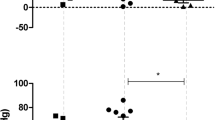Summary
The possible central regulation of cardiovascular system by serotoninergic neurones was investigated in rats by using a cross-circulated head preparation. Intracarotid injections of serotonin (5-HT, 0.1–10 μg) consistently produced neurally mediated vasodepression in the recipient body. Although intravenous injections of 5-HT (0.1–1 μg) caused similar depressor responses, larger doses (5–10 μg) caused biphasic responses, consisting of vasodepression followed by a sustained pressor response. Despite the biphasic blood pressure responses, sympathetic nerve activity was consistently reduced by the intravenous 5-HT.
Bilateral vagotomy abolished the vasodepressor responses to intravenous injections of 5-HT (10 μg) and made the responses purely pressor, but the vasodepressor responses to intracarotid injections of 5-HT (10 μg) were largely unaffected.
Following destruction of central noradrenergic neurones by intracerebroventricular injections of 6-hydroxydopamine, the vasodepressor responses to intracarotid 5-HT (1–10 μg), but not to the intravenous 5-HT, were significantly reduced.
These results suggest that intravenous injections of 5-HT reduce nerve activity by affecting the reflex mechanism via the vagus nerves. On the other hand, the vasodepression and reduction of the nerve activity by the intracarotid injections appears to be of central origin, and the vasodepression could be mediated via noradrenergic mechanisms in the brain.
Similar content being viewed by others
References
Antonaccio MJ, Robson RD (1974) L-Dopa in dogs: evidence for mediation through 5-HT release. Arch Int Pharmacodyn 212:89–102
Breese G, Cooper B (1977) Chemical lesioning; catecholamine pathways. In: Merers R (ed) Methods in psychopharmacology, vol 3. Academic Press Inc, New York, pp 27–28
De Jong W, Nijkamp FP, Bohus B (1975) Role of noradrenaline and serotonin in the central control of blood pressure in normotensive and spontaneously hypertensive rats. Arch Int Pharmacodyn 213:272–284
Dunkley B, Sanghvi I, Friedman E, Gershon S (1972) Comparison of behavioral and cardiovascular effects of L-dopa and 5-HTP in conscious dogs. Psychopharmacologia (Berlin) 26:161–172
Echizen H, Freed CR (1981) Long term infusion of 1-5-hydroxytryptophan increases brain serotonin turnover and decreases blood pressure in normotensive rats. J Pharmacol Exp Ther 220:579–584
Fuller RW, Holland DR, Yen TT, Bemis KG, Stamm NB (1979) Antihypertensive effects of fluoxetine and 1-5-hydroxytryptophan in rats. Life Sci 25:1237–1242
Goth A (1978) Serotonin and antiserotonins. In: Goth A (ed) Medical pharmacology. The Mosby Company, St Louis, p 200
Howe PRC, Stead BH, Lovemberg W, Chalmers JP (1982) Effects of central serotonin nerve lesions on blood pressure in normotensive and hypertensive rats. Clin Exp Pharmacol Physiol 9:335–339
Ito A, Schanberg SM (1972) Central nervous mechanisms responsible for blood pressure elevation induced by p-chlorophenylalanine. J Pharmacol Exp Ther 181:65–74
Krstic MK, Djurkovic D (1980) Analysis of cardiovascular responses to central administration of 5-hydroxytryptamine in rats. Neuropharmacology 19:455–463
Kuhn DM, Wolf WA, Lovenberg W (1980) Review of the central serotonergic neuronal system in blood pressure regulation. Hypertension 2:243–255
Laguzzi R, Talman WT, Reis DJ (1982) Serotonergic mechanisms in the nucleus tractus solitarius may regulate blood pressure and behaviour in the rat. Clin Sci 63:323s-326s
Lambert GA, Friedman E, Buchweitz E, Gershon S (1978) Involvement of 5-hydroxytryptamine in the central control of respiration, blood pressure and heart rate in the anesthetized rat. Neuropharmacology 17:807–813
Nava-Felix P, Hong E (1979) Nature of the serotonin receptors mediating hypotension. J Cardiovasc Pharmacol 1:461–466
Rapoport SI (1976) Sites and function of the blood-brain barrier. In: Rapoport SI (ed) Blood-brain barrier in physiology and medicine. Raven Press, New York, pp 76–79
Smitz FM, Van Essen H, Struyker-Boudier HAJ (1978) Serotoninmediated cardiovascular responses to electrical stimulation of the raphe nuclei in the rat. Life Sci 23:173–178
Takahashi H, Buñag RD (1980) Augmentation of centrally induced alpha-adrenergic vasodepression in spontaneously hypertensive rats. Hypertension 2:198–206
Wolf WA, Kuhn DM, Lovemberg W (1981a) Blood pressure responses to local application of serotonergic agents in the nucleus tractus solitarii. Eur J Pharmacol 69:291–299
Wolf WA, Kuhn DM, Lovemberg W (1981b) Pressor effects of dorsal raphe stimulation and intrahypothalamic application of serotonin in the spontaneously hypertensive rat. Brain Res 208:192–198
Author information
Authors and Affiliations
Rights and permissions
About this article
Cite this article
Takahashi, H. Cardiovascular and sympathetic responses to intracarotid and intravenous injections of serotonin in rats. Naunyn-Schmiedeberg's Arch. Pharmacol. 329, 222–226 (1985). https://doi.org/10.1007/BF00501872
Received:
Accepted:
Issue Date:
DOI: https://doi.org/10.1007/BF00501872




